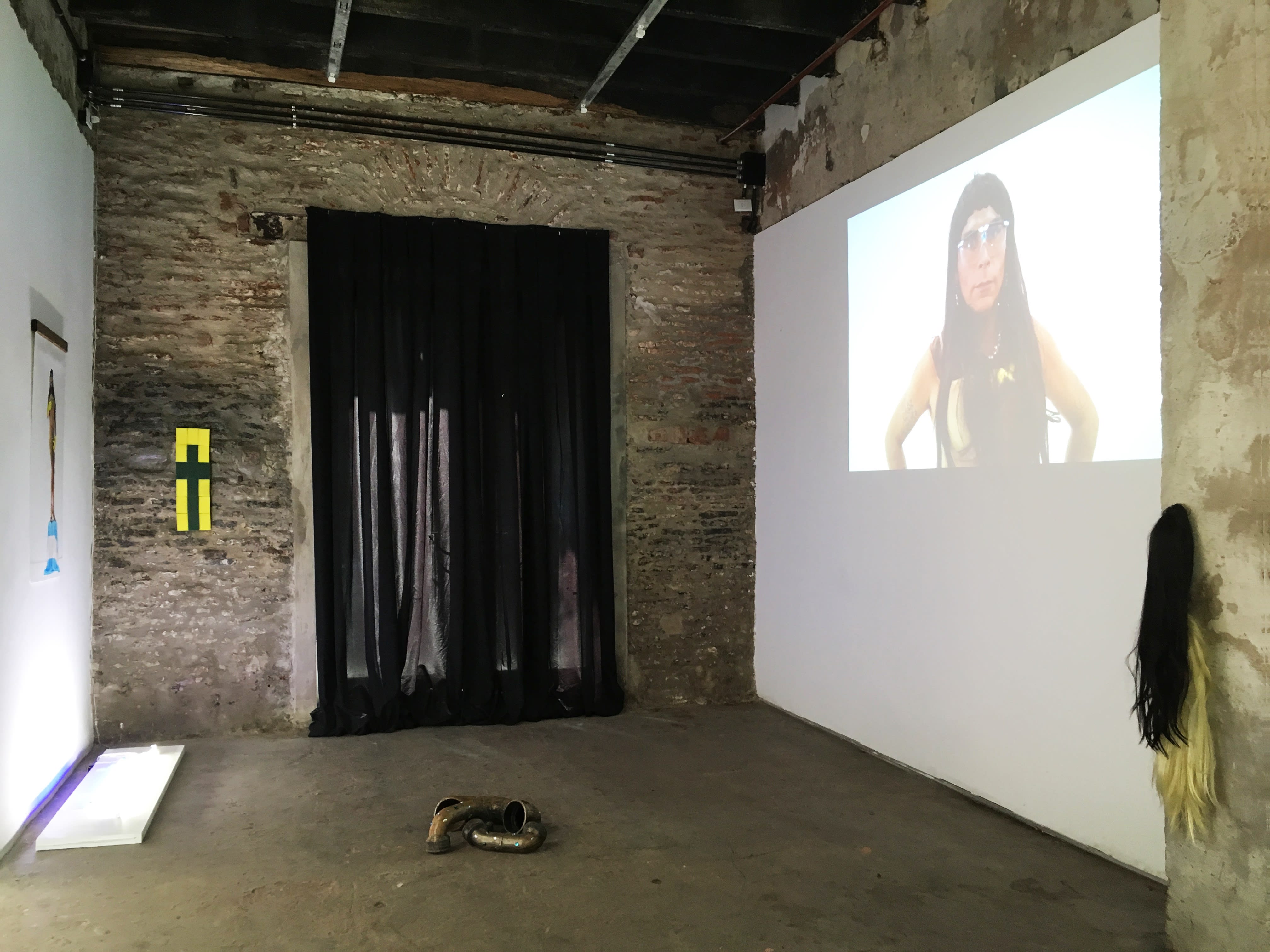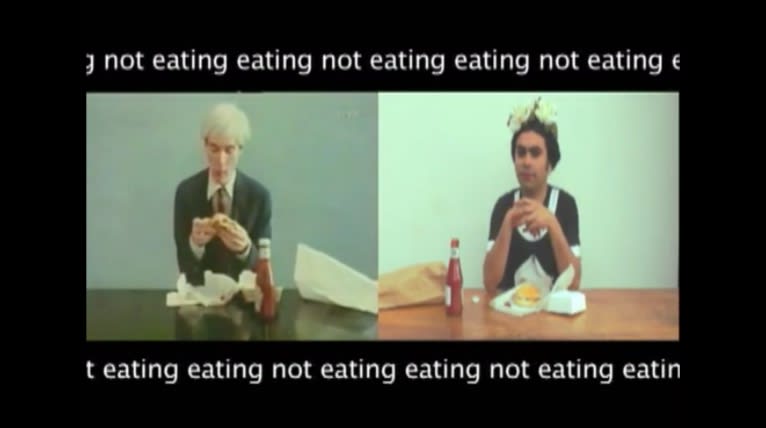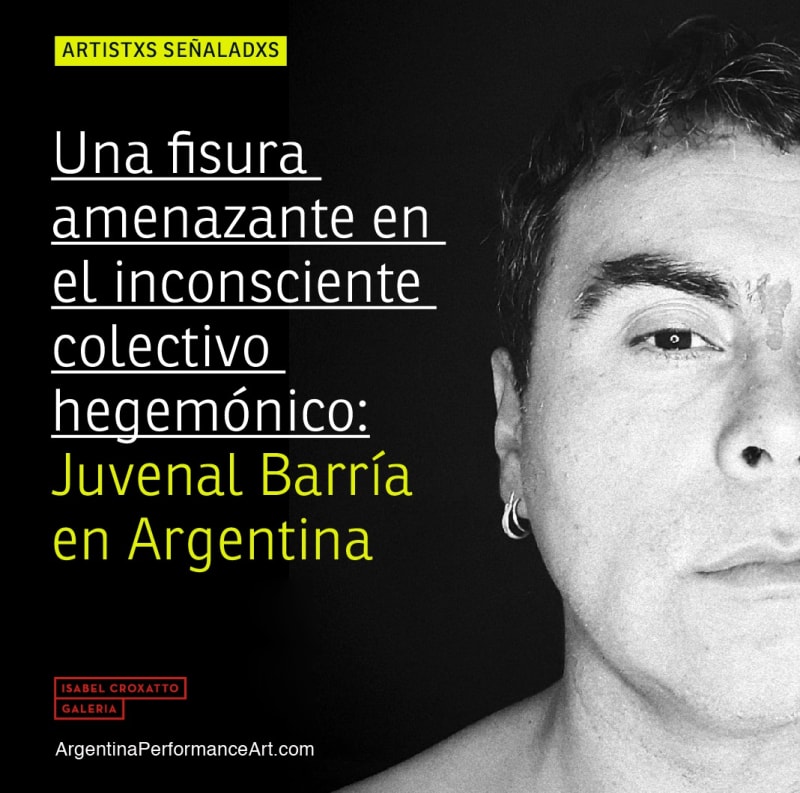Our represented artist Juvenal Barría is featured in the specialised digital platform Argentina Performance Art, dedicated to the performance theory in Argentina, with an in-depth interview and a review of some of his performance pieces made in that country.
Find the complete publication here (in Spanish), and an English translation below.
A threatening fissure in the hegemonic collective unconscious: Juvenal Barría in Argentina
Featured Artist: Juvenal Barría (Chile)
Juvenal Barría (Chonchi-Chiloé, 1979) is a Chilean visual artist and photographer. He has exhibited continuously since 2004, both in Chile and abroad. He lives and works in Valparaíso.
In Argentina, he developed works in 2008 and 2019, which we highlight below.
Juvenal uses his own body as a vehicle for ideas that he materialises through performance and its registry. His production is influenced by his personal history, his sexual orientation and his Huilliche ethnicity, as well as by concepts related to queer theory, decolonisation and class struggle. Starting from these notions, Juvenal generates simulations, narratives and fictions that represent, in his own words, a threatening fissure amid scenarios constructed to symbolise a heteronormative, patriarchal and hegemonic collective unconscious, with no possibility of error.
His works propose other routes through reality to disturb social forms and offer an experience of the simulacrum lived from different points, starting from transvestism to the trans as a visual concept and transformation as an axis of declaration, transgression and reflection on identities and social constructs.
The foundations of his work are linked to the contexts in which the artist is inserted, from personal problems to external circumstances that arise in the process. For Juvenal, art operates as a response to reality and contingencies, which in many cases does not necessarily present itself as an activist action but only as a mirror that challenges the viewer.
Juvenal's works in Argentina revolve around the figure of La Martuca, a character/alter ego that the artist began to develop in 2004. At that time, the artist was studying at university and was going through questions about his personal life, related to gender identity and homosexuality and what this meant at the beginning of the 2000s in Chile. At the same time, he was interested in raising some issues related to art institutions, in particular how the academy falls into the standardisation of production, generating a student profile that Juvenal did not identify with.
On a larger scale, he was also interested in questioning the image of the Latin American in art and on the market, the exoticism represented from and for the other, but which did not reveal the real existing roles. La Martuca emerges from the intersection of these questions as an exercise in personification, a kind of revelation about what it means to be Latin American and the privileged status of some at the expense of others. In this instance, the maid's attire is incorporated with all its symbolic charge, as a critique of colonial and patriarchal society and a world based on roles of power and class struggle. A metaphor that encapsulates what it means to belong to a territory, class and multiple identities.
La Martuca arises in Chile, and the circumstances of her creation and survival respond to the Chilean environment. Beyond the fact that the concept that surrounds her can easily be transferred to the Argentinean reality, what was it like to work with this incarnation in a different space and time? Did the character adapt or transform herself into a new Martuca?
Juvenal: La Martuca as a character emerged in 2006 as a way of presenting a work that denotes different charges on questions of gender and class struggle. This character concentrates on critical discursivities in response to these problems, which are very contingent both in Chilean and Latin American territory. The performances in which I have embodied La Martuca have been presented in different contexts, in Chile, Colombia, Ecuador, Bolivia, Peru, Brazil and Argentina. The idea is to generate a social dialogue with the environment, which is why in each process I have developed a territorial investigation that allows me to act from its happenings. In principle, this character is presented as a maid, adorned with different elements that suggest a certain link with the place where the action takes place.
Works produced in Argentina by Juvenal Barría
2019
Capital y Justicia (Capital and Justice)
Video-performance at Alberdi Residencia. Córdoba, Argentina.
Exhibited at Esaa Unquillo in collaboration with Isabel Croxatto Galería. Córdoba, Argentina.
In this performance, La Martuca crosses the Andes to the province of Córdoba to begin a new process of sanitisation, with the Palacio de Justicia and the Complejo Financiero Capitalinas in the Cordoban capital as locations. The process of sanitisation is a central concept in the works involving La Martuca and has several connotations: it is related to different cleaning activities that are ordered from a position of power over a subordinate, "doing the dirty work". Through the characterisation and the usage of domestic elements, such as cleaning sponges, plastic gloves and aprons, the artist generates a metaphor about the power game that exists in each of the instances of human existence as part of a system.
Furthermore, the concept of sanitisation is linked to standardisation, order and gentrification as integral parts of a process of territorial restructuring, present in Chile and other Latin American countries, which discards all identity, signs and intangible heritage that are not integrated into the order of capital, thus generating social divisions and fragmenting the territory. Hence their interest in acting in certain spaces and places that are evidence of "the processes of commodification in the neoliberal era".


After touring the city of Córdoba, Juvenal articulated this action that unites two spaces of power: the financial centre and the Palace of Justice. During the action, a bride Martuca, dressed in a suit made of floor rags, cleans these spaces, revealing their symbolic charge. The piece combines the absurd and the ironic to unmask the environment, transforming it into a naked and vulnerable territory where the artist constructs an alternative and disturbing narrative of the established.
The work incorporates an excerpt from Karl Marx's Das Kapital: As the capital and therefore wealth accumulates, there is a correspondingly increasing accumulation of misery among the majority of the population. The accumulation of capital at one pole is equivalent to the accumulation of misery at the other.

2019
RESET
Video-performance produced in residence at Munar, in collaboration with Isabel Croxatto Galería. Buenos Aires, Argentina.

For the performance at Munar, the artist presented a Porteño adaptation of La Martuca.
Juvenal arrived in Buenos Aires with a personal imagination about Argentinean identity that combined images of vedettes, the movement for the legalisation of abortion, the economic crisis, the Pope, etc. At the moment of developing the piece, the artist made use of this universe of references and adjusted La Martuca to her temporary scenario, turning her from a maid into a vedette: empowered, deified and without a boss. Thus Martuca M. was born, referring in her name to the Argentinean vedette Moria Casan.
The work is developed from the observation and study of the territorial situation of the neighbourhood of La Boca, where Munar is based. The local culture and the social and economic problems of the area challenged the artist to create the piece, as well as the process of gentrification that he identified in the neighbourhood and with which he established a link with his experience in the city of Valparaíso.

In the video performance, Martuca M., dressed as a vedette, takes an electric polisher and begins to remove the rust from some old pieces of pipe -found by the artist walking around the neighbourhood- to reveal the engraved phrase INDUSTRIA ARGENTINA. In his words, 'it is in the union of this contrast that the piece is generated, the power struggle is revealed, or rather the imposition of power, in this case, represented in a performance where the vedette Martuca M. appears aggressively polishing these found objects until they are clean, shiny and decorated. This metaphor for me represents these processes of sanitisation, speculation and transformation of the territories.'

RESET is part of an installation composed of pieces of pipe, adorned with white and light blue appliqués, and two long wigs, one blonde and one brunette. The video performance is accompanied by a photograph of Martuca M, dressed in a conchero, high heels and a vedette outfit, standing on a podium wrapped in the Argentinean flag.
The fictional aspect is present in all the works you have presented or developed in Argentina. La Martuca unfolds within small scenes charged with symbolism. To what extent are these representations premeditated actions? How did the context influence the process of creation and development of the works in Argentina?
Juvenal: In the case of Argentina, I was interested in working from a different visuality; here La Martuca became a vedette, but always using domestic materials, such as washing sponges and gloves. The sponges function as breast implant prostheses that question the clichéd image of the woman who is recognised within the show business, posing her as an icon subservient to the model. At the same time, I encountered another reality: the constant economic crisis and the gentrification that exists within certain disputed territories. I used construction materials and waste from properties that had been stripped of their inhabitants and united these two ideas in the phrase "tenés glamour para maquillar la decadencia" ['You have glamour to make up for decadence'] by Moria Casan.
2008
Eating Not Eating
Video-performance exhibited in Copia de Contrabando at Casa 13, Córdoba and at Galería Crimson, Buenos Aires.

The video performance Eating Not Eating explores the possibilities of gender as political fiction and as a stage for subversion. The production process of this piece involved the search, selection and editing of existing archives: using Andy Warhol's Andy Warhol Eating a Hamburger as a counterpart, the work once again includes La Martuca who, in this case, observes the artist (white, male, from a hegemonic country) eating while she does not take a bite of her food.
The piece shows a narrative scenario assembled from archive images that function as visualisers of a representation of politics and gender, where power is shown in its conceptual and objectual dimension, overloaded and obscene.
Find out more of Juvenal Barría here.


